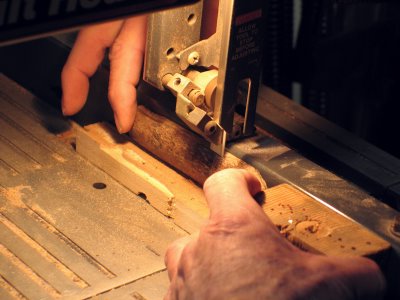Making Scales 102
Don't be afraid to leave comments, everyone. It's the only way I know anyone is interested in this drivel. I would like to know if this info is helpful because it is going into the update to my CD. Especially ask questions on things that were already covered. Sometimes I just assume that some of the things I do are common knowledge. That may or may not be the case. In addition, if you have a tip you would like to add to the process, let me know. Some of you guys have some very good ideas. If you don't want to say anything on this blog, email me at officerE@comcast.net.
The next photo shows the small ridge lines left on the material from the band saw. These are the ones that need to be taken off by the sanding stages. If you don't have a disc sander, an upside down mounted belt sander would work. So would a regular stationary belt sanding model. The real throw-back would be a 12 by 12 inch block of granite to be used as a flat base for sanding paper. 100 grit wet/dry paper would be fine for this process. You can get 12 by 12 blocks of granite at any good leather hobby store. They are used as a base for tooling leather.

Once you have flattened the slab, it should look something like this...

Now it is time to slice the two halfs into matching scales. To do that, we use the rip fence of the band saw, jig saw, or scroll saw. The jig saw being the last choice. Actually a table saw would be the last choice. Using that would eliminate one set of usable scales entirely.
I set the rip fence to approximately 1/8 of an inch. Remember, there are more sanding steps, so some of this 1/8 of an inch is going to disappear. Notice the piece of wood beneath the piece of oosik. That is used as a support to the thin slices that will be made. Otherwise, the larger slot in the table of the saw allows too much movement of the material as it is being cut. I hope that made sense.


I keep forgetting to say something about the appearance of my workshop area. It normally does not look this messy. I am in the process of packing everything up for the move to my new house, which means everything is coming off the walls and out of the storage cabinets. My move is tentatively scheduled for the second week in April. I have been taking the things I figure I won't need and taking them to a storage unit that is only a mile away from the new house. Of course, once it has been moved to storage, I wind up needing it...
Once you have cut one half of the material into equal slices, do the other one. This particular piece of oosik gave three sets of usable scales. Not too bad. Keep the matching sets together. Also keep in mind that this piece of oosik was only about 4 1/2 inches long. It was going to be used for a knife. But, it is of no consequence because this blog is how to make scales with liners. Oosik is probably strong enough to be used without liners if it is long enough. But, I think you would have to have a solid 1/8 inch finished dimension to make them work. Remember, this stuff can be found in two foot lengths, so keep an eye out for it. Knife shows are your best resource.

End of Making scales 102. Comments please...


6 Comments:
I guess I'm waiting for the liner work to show up before asking too many questions. So far it seems pretty straight forward.
Regards
Christian
I told my daughter I want to make scales for my razor with walrus penis material - she said - eeew sick! Oosik - I thought that was funny.
So far, this seems straightforward...and your blog is an excellent resource. I've been going through the entire thing...ver nice.
-Benjamin
Hey Bill, I just found your blog and wanted to both thank you, and ask if you are planning on adding to it?
Many thanks for such a wonderful resource, you truly are talented
Best wishes
Ralfy
In your post, you mentioned using piece of granite for a flat sanding surface. I want to point out that glass tabletops can also be very effective. Ceramic tiles may also get the job done.
To the man without a name: I use glass for a lot of things as well. The granite I was actually referring to is specially ground to very tight tolerances. I'm talking about a single thousands within a 5-inch circle. I am not talking about the one you can get from Tandy Leather. As far as a tile providing a good flat surface - I think I'd have to disagree with you all day long. Sorry.
Post a Comment
<< Home